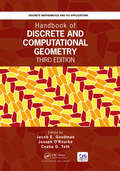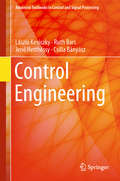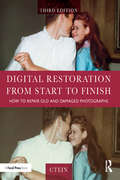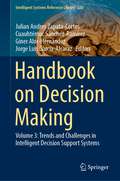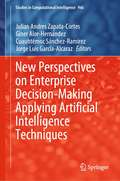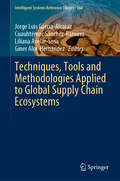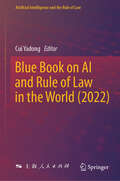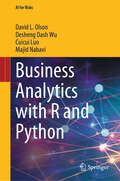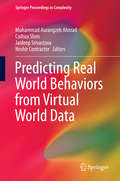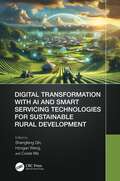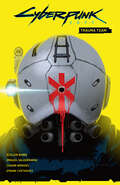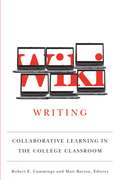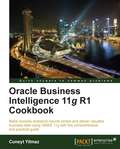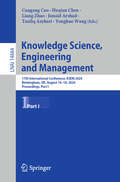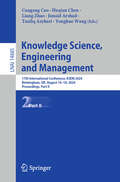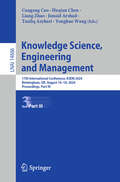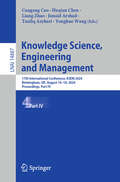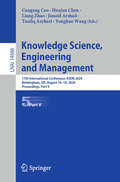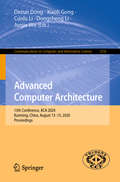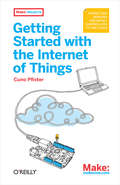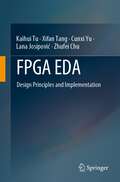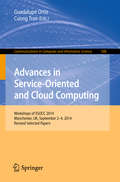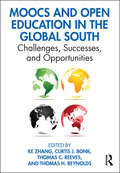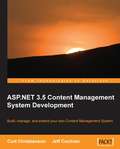- Table View
- List View
Handbook of Discrete and Computational Geometry (Discrete Mathematics and Its Applications)
by Jacob E. Goodman Csaba D. Tóth Joseph O’RourkeThe Handbook of Discrete and Computational Geometry is intended as a reference book fully accessible to nonspecialists as well as specialists, covering all major aspects of both fields.The book offers the most important results and methods in discrete and computational geometry to those who use them in their work, both in the academic world—as researchers in mathematics and computer science—and in the professional world—as practitioners in fields as diverse as operations research, molecular biology and robotics.Discrete geometry has contributed significantly to the growth of discrete mathematics in recent years. This has been fueled partly by the advent of powerful computers and by the recent explosion of activity in the relatively young field of computational geometry. This synthesis between discrete and computational geometry lies at the heart of this Handbook.A growing list of application fields includes combinatorial optimization, computer-aided design, computer graphics, crystallography, data analysis, error-correcting codes, geographic information systems, motion planning, operations research, pattern recognition, robotics, solid modeling, and tomography.
Control Engineering: From The Basics To The Applications (Advanced Textbooks in Control and Signal Processing)
by Ruth Bars László Keviczky Jenő Hetthéssy Csilla BányászThis book offers fundamental information on the analysis and synthesis of continuous and sampled data control systems. It includes all the required preliminary materials (from mathematics, signals and systems) that are needed in order to understand control theory, so readers do not have to turn to other textbooks. Sampled data systems have recently gained increasing importance, as they provide the basis for the analysis and design of computer-controlled systems. Though the book mainly focuses on linear systems, input/output approaches and state space descriptions are also provided. Control structures such as feedback, feed forward, internal model control, state feedback control, and the Youla parameterization approach are discussed, while a closing section outlines advanced areas of control theory. Though the book also contains selected examples, a related exercise book provides Matlab/Simulink exercises for all topics discussed in the textbook, helping readers to understand the theory and apply it in order to solve control problems. Thanks to this combination, readers will gain a basic grasp of systems and control, and be able to analyze and design continuous and discrete control systems.
Digital Restoration from Start to Finish: How to Repair Old and Damaged Photographs
by CteinThis third edition of Digital Restoration from Start to Finish walks you step-by-step through the entire process of restoring old photographs and repairing new ones using Adobe Photoshop, Photoshop Elements, GIMP and more. This best-selling guide is now updated with the latest software advancements, and new techniques including hand-tinting in lab, repairing water damaged photos, and tips for the spot healing brush and masked layers. No process detail is overlooked, from choosing the right hardware and software, getting the photographs into the computer, getting the finished photo out of the computer and preserving it for posterity. LEARN HOW TO: Scan faded and damaged prints or films Improve snapshots with Shadow/Highlight adjustment Correct uneven exposure Fix color and skin tones quickly with Curves, plug-ins, and Hue/Saturation adjustment layers Correct uneven exposure and do dodging and burning-in with adjustment layers Hand-tint your photographs easily Correct skin tones with airbrush layers Clean up dust and scratches speedily and effectively Repair small and large cracks with masks and filters Eliminate tarnish and silvered-out spots from a photograph in just a few steps Minimize unwanted print surface textures Erase mildew spots Eliminate dots from newspaper photographs Increase sharpness and fine detail Maximize print quality
Handbook on Decision Making: Volume 3: Trends and Challenges in Intelligent Decision Support Systems (Intelligent Systems Reference Library #226)
by Jorge Luis García-Alcaraz Giner Alor-Hernández Cuauhtémoc Sánchez-Ramírez Julian Andres Zapata-CortesThis book presents different techniques and methodologies used to improve the intelligent decision-making process and increase the likelihood of success in companies of different sectors such as Financial Services, Education, Supply Chain, Energy Systems, Health Services, and others. The book contains and consolidates innovative and high-quality research contributions regarding the implementation of techniques and methodologies applied in different sectors. The scope is to disseminate current trends knowledge in the implementation of artificial intelligence techniques and methodologies in different fields such as: Logistics, Software Development, Big Data, Internet of Things, Simulation, among others. The book contents are useful for Ph.D. researchers, Ph.D. students, master and undergraduate students of different areas such as Industrial Engineering, Computer Science, Information Systems, Data Analytics, and others.
New Perspectives on Enterprise Decision-Making Applying Artificial Intelligence Techniques (Studies in Computational Intelligence #966)
by Jorge Luis García-Alcaraz Giner Alor-Hernández Cuauhtémoc Sánchez-Ramírez Julian Andres Zapata-CortesThis book presents different techniques and methodologies that used to help improve the decision-making process and increase the likelihood of success in sector as follows: agriculture, financial services, logistics, energy services, health and others. This book collects and consolidates innovative and high-quality research contributions regarding the implementation techniques and methodologies applied in different industrial sectors. The scope is to disseminate current trends knowledge in the implementation of artificial intelligence techniques and methodologies in different fields as follows: supply chain, business intelligence, e-commerce, social media and others. The book contents are useful for Ph.D., Ph.D. students, master and undergraduate students, and professional and students in industrial engineering, computer science, information systems, data analytics and others.
Techniques, Tools and Methodologies Applied to Global Supply Chain Ecosystems (Intelligent Systems Reference Library #166)
by Jorge Luis García-Alcaraz Giner Alor-Hernández Cuauhtémoc Sánchez-Ramírez Liliana Avelar-SosaThis book presents the latest developments concerning techniques, tools, and methodologies in supply chain ecosystems. It gathers contributions from a variety of experts, who analyze a range of case studies and industrial sectors such as manufacturing, energy, agricultural, healthcare, humanitarian logistics, and urban goods distribution, to name but a few. The book is chiefly intended to meet the needs of two sectors: firstly, the academic sector, so as to familiarize students, professors, and researchers with the tools that are now being used to optimize supply chains; and secondly, the industrial and managerial sector, so that supply chain management practitioners can benefit from methods and tools that are yielding valuable results in other contexts.
Blue Book on AI and Rule of Law in the World (Artificial Intelligence and the Rule of Law)
by Cui YadongThis book focuses on the development of artificial intelligence and rule of law in the world, by collecting and summarizing the information about the development of artificial intelligence and rule of law in China and the world, covering topics like AI strategy, policy, law, theoretical research, practical application, etc. It makes an in-depth analysis so as to provide an objective, fair, and accurate report. The purpose is to promote the study of AI and law, promote the construction of AI and rule of law system, and create an AI and rule of law environment. In particular, it aims to play an active role in promoting the establishment of legislative norms, legal systems, policy systems, and ethical norms that are compatible with the innovative development of AI, promoting the implementation of a new generation of national AI development strategies and ensuring the safe, reliable, controllable, healthy, and sustainable development of AI. It is hoped that this book provides a useful reference for researchers of AI and law.
Business Analytics with R and Python (AI for Risks)
by David L. Olson Desheng Dash Wu Cuicui Luo Majid NabaviThis book provides an overview of data mining methods in the field of business. Business management faces challenges in serving customers in better ways, in identifying risks, and analyzing the impact of decisions. Of the three types of analytic tools, descriptive analytics focuses on what has happened and predictive analytics extends statistical and/or artificial intelligence to provide forecasting capability. Chapter 1 provides an overview of business management problems. Chapter 2 describes how analytics and knowledge management have been used to better cope with these problems. Chapter 3 describes initial data visualization tools. Chapter 4 describes association rules and software support. Chapter 5 describes cluster analysis with software demonstration. Chapter 6 discusses time series analysis with software demonstration. Chapter 7 describes predictive classification data mining tools. Applications of the context of management are presented in Chapter 8. Chapter 9 covers prescriptive modeling in business and applications of artificial intelligence.
Predicting Real World Behaviors from Virtual World Data
by Muhammad Aurangzeb Ahmad Cuihua Shen Jaideep Srivastava Noshir ContractorThere is a growing body of literature that focuses on the similarities and differences between how people behave in the offline world vs. how they behave in these virtual environments. Data mining has aided in discovering interesting insights with respect to how people behave in these virtual environments. The book addresses prediction, mining and analysis of offline characteristics and behaviors from online data and vice versa. Each chapter will focus on a different aspect of virtual worlds to real world prediction e. g. , demographics, personality, location, etc.
Digital Transformation with AI and Smart Servicing Technologies for Sustainable Rural Development
by Shengfeng Qin Hongan Wang Cuixia MaThis book introduces and demonstrates the state-of-the art research and development in tackling sustainable urban and rural integration, supported by digitalization and digital transformation in rural areas with Industry 4.0/5.0 technologies. Digital Transformation with AI and Smart Servicing Technologies for Sustainable Rural Development is centered around how to deal with the sustainable urban and rural integration with advanced digital technologies such as artificial intelligence (AI), Big Data, Crowdsourcing, Crowdsensing and digital twin applications.Digital Transformation with AI and Smart Servicing Technologies for Sustainable Rural Development comes from the authors international collaborative projects funded by British Council and National Sciences Foundation of China and our Newton Prize Winning project founded by UK Department for Business, Energy & Industrial Strategy. It covers digital platform design with integrated crowdsourcing, crowdsensing and digital twin technologies for smart community services and governing. The authors discuss smart textile design for health and social care and VR/AR based tele-healthcare services for plants, livestock, and people. It also presents smart building technologies and integrated services for remote rural areas.This book will be a valuable reference for multidisciplinary researchers, policy makers, urban and rural development engineers, and university students to support their research and work in AI and smart technology applications.
Cyberpunk 2077: Trauma Team
by Cullen BunnDive deeper into the world of Cyberpunk 2077!Nadia, an assistant EMT for a privately-owned business known as Trauma Team International, is the sole survivor of a failed rescue mission turned shootout.After she agrees to continue work for an upcoming extraction mission, Nadia discovers that her new extraction subject is Apex—the man who's responsible for Nadia's former team members' deaths. A hundred floors high in a skyscraper filled with members of Apex's rival gang, Nadia and her team must complete the extraction. Cullen Bunn (Harrow County, Uncanny X-Men) and Miguel Valderrama (GIANTS, Hunters) introduce a series based on CD Projekt Red's game Cyberpunk 2077!Collects Cyberpunk 2077: Trauma Team #1-4.
Wiki Writing: Collaborative Learning in the College Classroom
by Cummings Matt Robert E. BartonWhen most people think of wikis, the first---and usually the only---thing that comes to mind is Wikipedia. The editors ofWiki Writing: Collaborative Learning in the College Classroom, Robert E. Cummings and Matt Barton, have assembled a collection of essays that challenges this common misconception, providing an engaging and helpful array of perspectives on the many pressing theoretical and practical issues that wikis raise. Written in an engaging and accessible manner that will appeal to specialists and novices alike,Wiki Writingdraws on a wealth of practical classroom experiences with wikis to offer a series of richly detailed and concrete suggestions to help educators realize the potential of these new writing environments. Robert E. Cummings began work at Columbus State University in August 2006 as Assistant Professor of English and Director of First-Year Composition. Currently he also serves as the Writing Specialist for CSU's Quality Enhancement Plan, assisting teachers across campus in their efforts to maximize student writing in their curriculum. He recently concluded a three-year research study with the Inter/National Coalition for Electronic Portfolio Research and continues to research in the fields of computers and writing, writing across the curriculum, writing in the disciplines, and curricular reform in higher education. Matt Barton is Assistant Professor, St. Cloud State University, Department of English-Rhetoric and Applied Writing Program. His research interests are rhetoric, new media, and computers and writing. He is the author ofDungeons and Desktops: A History of Computer Role-Playing Gamesand has published in the journalsText and Technology,Computers and Composition,Game Studies, andKairos. He is currently serving as Associate Editor ofKairosnewsand Managing Editor ofArmchair Arcade. "Wiki Writingwill quickly become the standard resource for using wikis in the classroom. " ---Jim Kalmbach, Illinois State Universitydigitalculturebooks is an imprint of the University of Michigan Press and the Scholarly Publishing Office of the University of Michigan Library dedicated to publishing innovative and accessible work exploring new media and its impact on society, culture, and scholarly communication. Visit the website at www. digitalculture. org .
Oracle Business Intelligence 11g R1 Cookbook
by Cuneyt YilmazProviding simple solutions, useful techniques and best practices to ensure that your business is intelligent as it can possibly be, this book is a must buy for anyone that works with Oracle BI.If you are a business analyst, BI administrator or developer working with Oracle Business Intelligence 11g R1 then this book is exactly what you have been looking for. Hands on practical examples, real world solutions and best practices make this book an essential guide for Oracle BI. Clear a space on your desk as you won't want this handy reference to be too far away.
Knowledge Science, Engineering and Management: 17th International Conference, KSEM 2024, Birmingham, UK, August 16–18, 2024, Proceedings, Part I (Lecture Notes in Computer Science #14884)
by Huajun Chen Liang Zhao Cungeng Cao Junaid Arshad Taufiq Asyhari Yonghao WangThe five-volume set LNCS 14884, 14885, 14886, 14887 & 14888 constitutes the refereed deadline proceedings of the 17th International Conference on Knowledge Science, Engineering and Management, KSEM 2024, held in Birmingham, UK, during August 16–18, 2024. The 160 full papers presented in these proceedings were carefully reviewed and selected from 495 submissions. The papers are organized in the following topical sections: Volume I: Knowledge Science with Learning and AI (KSLA) Volume II: Knowledge Engineering Research and Applications (KERA) Volume III: Knowledge Management with Optimization and Security (KMOS) Volume IV: Emerging Technology Volume V: Special Tracks
Knowledge Science, Engineering and Management: 17th International Conference, KSEM 2024, Birmingham, UK, August 16–18, 2024, Proceedings, Part II (Lecture Notes in Computer Science #14885)
by Huajun Chen Liang Zhao Cungeng Cao Junaid Arshad Taufiq Asyhari Yonghao WangThe five-volume set LNCS 14884, 14885, 14886, 14887 & 14888 constitutes the refereed deadline proceedings of the 17th International Conference on Knowledge Science, Engineering and Management, KSEM 2024, held in Birmingham, UK, during August 16–18, 2024. The 160 full papers presented in these proceedings were carefully reviewed and selected from 495 submissions. The papers are organized in the following topical sections: Volume I: Knowledge Science with Learning and AI (KSLA) Volume II: Knowledge Engineering Research and Applications (KERA) Volume III: Knowledge Management with Optimization and Security (KMOS) Volume IV: Emerging Technology Volume V: Special Tracks
Knowledge Science, Engineering and Management: 17th International Conference, KSEM 2024, Birmingham, UK, August 16–18, 2024, Proceedings, Part III (Lecture Notes in Computer Science #14886)
by Huajun Chen Liang Zhao Cungeng Cao Junaid Arshad Taufiq Asyhari Yonghao WangThe five-volume set LNCS 14884, 14885, 14886, 14887 & 14888 constitutes the refereed deadline proceedings of the 17th International Conference on Knowledge Science, Engineering and Management, KSEM 2024, held in Birmingham, UK, during August 16–18, 2024. The 160 full papers presented in these proceedings were carefully reviewed and selected from 495 submissions. The papers are organized in the following topical sections: Volume I: Knowledge Science with Learning and AI (KSLA) Volume II: Knowledge Engineering Research and Applications (KERA) Volume III: Knowledge Management with Optimization and Security (KMOS) Volume IV: Emerging Technology Volume V: Special Tracks
Knowledge Science, Engineering and Management: 17th International Conference, KSEM 2024, Birmingham, UK, August 16–18, 2024, Proceedings, Part IV (Lecture Notes in Computer Science #14887)
by Huajun Chen Liang Zhao Cungeng Cao Junaid Arshad Taufiq Asyhari Yonghao WangThe five-volume set LNCS 14884, 14885, 14886, 14887 & 14888 constitutes the refereed deadline proceedings of the 17th International Conference on Knowledge Science, Engineering and Management, KSEM 2024, held in Birmingham, UK, during August 16–18, 2024. The 160 full papers presented in these proceedings were carefully reviewed and selected from 495 submissions. The papers are organized in the following topical sections: Volume I: Knowledge Science with Learning and AI (KSLA) Volume II: Knowledge Engineering Research and Applications (KERA) Volume III: Knowledge Management with Optimization and Security (KMOS) Volume IV: Emerging Technology Volume V: Special Tracks
Knowledge Science, Engineering and Management: 17th International Conference, KSEM 2024, Birmingham, UK, August 16–18, 2024, Proceedings, Part V (Lecture Notes in Computer Science #14888)
by Huajun Chen Liang Zhao Cungeng Cao Junaid Arshad Taufiq Asyhari Yonghao WangThe five-volume set LNCS 14884, 14885, 14886, 14887 & 14888 constitutes the refereed deadline proceedings of the 17th International Conference on Knowledge Science, Engineering and Management, KSEM 2024, held in Birmingham, UK, during August 16–18, 2024. The 160 full papers presented in these proceedings were carefully reviewed and selected from 495 submissions. The papers are organized in the following topical sections: Volume I: Knowledge Science with Learning and AI (KSLA) Volume II: Knowledge Engineering Research and Applications (KERA) Volume III: Knowledge Management with Optimization and Security (KMOS) Volume IV: Emerging Technology Volume V: Special Tracks
Advanced Computer Architecture: 13th Conference, ACA 2020, Kunming, China, August 13–15, 2020, Proceedings (Communications in Computer and Information Science #1256)
by Junjie Wu Xiaoli Gong Dezun Dong Cunlu Li Dongsheng LiThis book constitutes the refereed proceedings of the 13th Conference on Advanced Computer Architecture, ACA 2020, held in Kunming, China, in August 2020. Due to the COVID-19 pandemic the conference was held online. The 24 revised full papers presented were carefully reviewed and selected from 105 submissions. The papers of this volume are organized in topical sections on: interconnection network, router and network interface architecture; accelerator-based, application-specific and reconfigurable architecture; processor, memory, and storage systems architecture; model, simulation and evaluation of architecture; new trends of technologies and applications.
Getting Started with the Internet of Things: Connecting Sensors and Microcontrollers to the Cloud
by Cuno PfisterWhat is the Internet of Things? It's billions of embedded computers, sensors, and actuators all connected online. If you have basic programming skills, you can use these powerful little devices to create a variety of useful systems—such as a device that waters plants when the soil becomes dry. This hands-on guide shows you how to start building your own fun and fascinating projects.Learn to program embedded devices using the .NET Micro Framework and the Netduino Plus board. Then connect your devices to the Internet with Pachube, a cloud platform for sharing real-time sensor data. All you need is a Netduino Plus, a USB cable, a couple of sensors, an Ethernet connection to the Internet—and your imagination.Develop programs with simple outputs (actuators) and inputs (sensors)Learn about the Internet of Things and the Web of ThingsBuild client programs that push sensor readings from a device to a web serviceCreate server programs that allow you to control a device over the WebGet the .NET classes and methods needed to implement all of the book's examples
FPGA EDA: Design Principles and Implementation
by Kaihui Tu Xifan Tang Cunxi Yu Lana Josipović Zhufei ChuThis book focuses on FPGA EDA tools, the very foundation of FPGA technology. Instead of illustrating how to use them, this book dives into the tools themselves, revealing how these tools are being designed and how they may improve. Unlike other semiconductors, FPGA has a distinctive two-stage EDA system: chip design EDA and application design EDA.State-of-the-art algorithms, data models and design methodologies/standards are the main concerns of this book, and these will be very helpful for FPGA EDA engineers and researchers to obtain a bird’s eye view of this complicated knowledge system. In the chip design EDA part, full-custom and semicustom methodologies bring up ASIC-like EDA tools, and in the application design EDA side, typical topics including high-level synthesis, logic synthesis, physical implementation, bitstream configuration, etc., are well discussed.
Advances in Service-Oriented and Cloud Computing: Workshops of ESOCC 2014, Manchester, UK, September 2-4, 2014, Revised Selected Papers (Communications in Computer and Information Science #508)
by Guadalupe Ortiz Cuong TranThis volume contains the technical papers presented in the four high-quality workshops associated with the European Conference on Service-Oriented and Cloud Computing, ESOCC 2014, held in Manchester, UK, in September 2014: 4th International Workshop on Adaptive Services for the Future Internet, WAS4FI 2014, 2nd International Workshop on Cloud for IoT, CLIoT 2014, 2nd International Workshop on Cloud Service Brokerage, CSB 2014, and Seamless Adaptive Multi-cloud Management of Service-based Applications, SeaCloudS Workshop. The 19 revised full papers and 3 short papers were carefully reviewed and selected from 39 submissions. They focus on specific topics in service-oriented and cloud computing domains as cloud computing, service buses, Web services, service-oriented architectures, event-driven architectures, enterprise architectures, business process management, software selection and adaptation.
Test Yourself On Build a Large Language Model (From Scratch)
by Curated From Build A Large Language ModelSebastian Raschka&’s bestselling book Build a Large Language Model (From Scratch) is the best way to learn how Large Language Models function. Summary With over 350 pages in seven chapters and five Appendixes, it guides you step-by-step in building an entire large language model similar to GPT-2. It uses Python and the PyTorch deep learning library. It&’s a unique way to learn this subject, which some believe is the only way to truly learn: you build a model yourself. Even with the clear explanations, diagrams, and code in the book, learning a complex subject is still hard. This Test Yourself guide intends to make it a little easier. The structure mirrors the structure of Build a Large Language Model (From Scratch), focusing on key concepts from each chapter. You can test yourself with multiple-choice quizzes, questions on code and key concepts, and questions with longer answers that push you to think critically. The answers to all questions are provided. Depending on what you know at any point, this Test Yourself guide can help you in different ways. It will solidify your knowledge if used after reading a chapter. But it will also benefit you if you digest it before reading. By testing yourself on the main concepts and their relationships you are primed to navigate a chapter more easily and be ready for its messages. We recommend using it before and after reading, as well as later when you have started forgetting. Repeated learning solidifies our knowledge and integrates it with related knowledge already in our long-term memory. What's inside • Questions on code and key concepts • Critical thinking exercises requiring longer answers • Answers for all questions About the reader For readers of Build a Large Language Model (From Scratch) who want to enhance their learning with exercises and self-assessment tools. About the author Curated from Build a Large Language Model (From Scratch).
MOOCs and Open Education in the Global South: Challenges, Successes, and Opportunities
by Thomas C. Reeves Ke Zhang Thomas H. Reynolds Curt BonkWith e-learning technologies evolving and expanding at high rates, organizations and institutions around the world are integrating massive open online courses (MOOCs) and other open educational resources (OERs). MOOCs and Open Education in the Global South explores the initiatives that are leveraging these flexible systems to educate, train, and empower populations previously denied access to such opportunities. Featuring contributors leading efforts in rapidly changing nations and regions, this wide-ranging collection grapples with accreditation, credentialing, quality standards, innovative assessment, learner motivation and attrition, and numerous other issues. The provocative narratives curated in this volume demonstrate how MOOCs and OER can be effectively designed and implemented in vastly different ways in particular settings, as detailed by experts from Asia, Latin America, the Middle East, Africa, the Pacific/Oceania, and the Caribbean. This comprehensive text is an essential resource for policy makers, instructional designers, practitioners, administrators, and other MOOC and OER community stakeholders.
ASP.NET 3.5 CMS Development
by Curt Christianson Jeff CochranThis step-by-step tutorial shows the reader how to build an ASP.NET Content Management System from scratch. You will first learn the basics of a content management system and how to set up the tools you need to build your site. Then, you start building your site, setting up users, and adding content to your site. You will be able to edit the content of your site and also manage its layout all by yourself. Towards the end, you will learn to manage your site from a single point and will have all the information you need to extend your site to make it more powerful. Filled with plenty of code snippets and screen images to keep you on track as well as numerous additional samples to show you all the exciting alternatives to explore, this book prepares you for all the challenges you can face in development. This book is for beginner to intermediate ASP.NET users who have managed to learn Visual Web Developer and want to take on their first real-world application. It will help those who have used SQL Server Express, completed a few sample projects, and now wish to explore a Content Management System.
